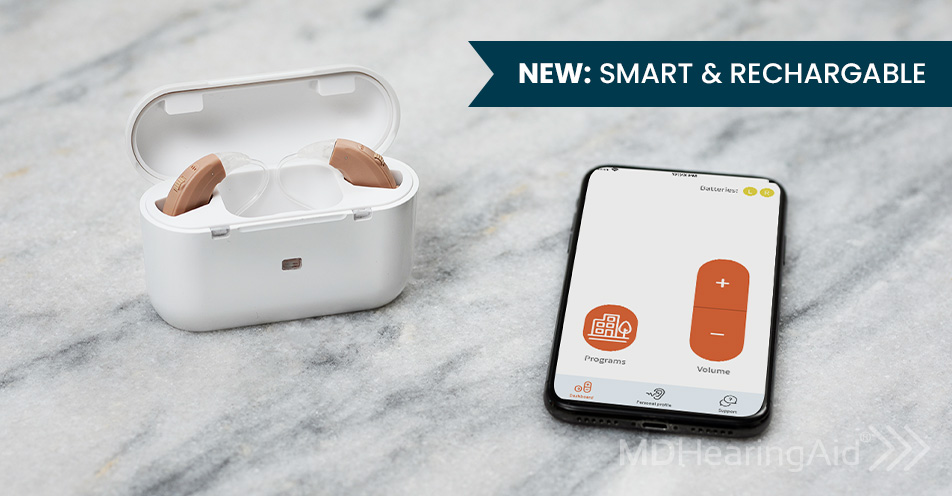Every hearing aid features an omnidirectional microphone, and many include both an omnidirectional and directional microphone. Directional microphones pick up sound waves from a specific direction, while omnidirectional microphones pick up sound waves from all directions. Both have their place in a modern hearing aid, yet some hearing aids don’t include directional microphones.
In this article, we will explain the purposes served by both omnidirectional and directional microphones, and why you may want to invest in a hearing aid with a directional microphone—especially if you want to hear what people are saying in noisy environments.
What Are Omnidirectional Microphones?
Omnidirectional microphones pick up all sounds coming from all directions, regardless of whether it’s a noisy refrigerator behind you, an airplane flying overhead, or the voices of all the people in a restaurant. This is fine if you’re in a relatively quiet place and want to hear distant sounds, like a car pulling up to your house, the television, a knock on the door, or the mail courier dropping off a package. But in a noisy place like a restaurant, it’s a problem.
- Benefits of omnidirectional microphones: Omnidirectional microphones are valuable when there isn’t a lot of noise or background sounds. If you just want an inexpensive solution for basic listening at home, a hearing aid with only an omnidirectional microphone is great.
- Challenges of omnidirectional microphones: If you want to socialize at parties, restaurants, cafes, and concerts – where you’ll encounter complex listening situations – an omnidirectional microphone will only make listening more difficult. We can’t stress this enough: A hearing aid with a directional microphone is essential for noisy places.
What Are Directional Microphones?
Directional microphones use their “directionality” to focus on sounds coming from a specific location. The simplest directional microphones amplify the volume of important sounds that enter the microphone from a fixed, front-facing direction. In this way, simple directional microphones work like bifocals on your glasses. All you have to do is turn your head to face someone in a loud restaurant to hear their voice better.
Directional microphone technology doesn’t stop there. More advanced versions – known as “adaptive directional microphones” – work in conjunction with your hearing aid’s noise reduction technology to zero in on the most important sounds in the room, highlight speech sounds, and increase the volume of those sounds over background noises. This allows your hearing aid to focus on the person sitting in front of you. However, when the server comes, the hearing aid will recognize a new, close speech signal, and widen the listening area to hear the server as well, without needing to turn your head.
- Benefits of directional microphones: A directional microphone helps you achieve the clearest listening in a noisy restaurant, meeting, or party.
- Challenges of directional microphones: Any kind of directional microphone will give you dramatically better sound quality in a noisy environment, but there are many types of directional microphone technologies on the market. Make sure you know what to expect from the technology before making a purchase (see below: Types of Directional Microphone Technology).
“The Cocktail Party Effect”: Omnidirectional Microphones vs. Directional Microphones
The cocktail party effect refers to your brain’s ability to focus on specific voices among many other voices. This is how you can hear your name being mentioned in a conversation on the other side of a room, and how you focus on your conversation over the many voices around you. Your brain can isolate and focus on certain sounds.
Unfortunately, your “cocktail party” listening abilities are the first to go when you suffer from hearing loss. Listening in noise becomes increasingly difficult because your brain isn’t receiving the same clarity of sound information.
Here’s how omnidirectional and directional microphones affect your listening abilities:
- Omnidirectional microphones: In certain circumstances, omnidirectional mics could make listening in noisy environments like restaurants harder or more frustrating. That’s because they pick up and amplify all sounds equally. Nevertheless, having an omnidirectional-only hearing aid is usually better than having nothing at all.
- Directional microphones: Directional microphones won’t restore all your “cocktail party” listening abilities, but they will restore some of them in surprising and incredible ways. The directionality of the microphone helps you discern the voices of people sitting near you – which is a tremendous gift if you suffer from hearing loss.
Types of Directional Microphone Technology
Now that you understand the “why” of directional microphones, let’s explore the different types of directional microphone technology:
- Simple directional microphones: Simple directional microphones need to have two sound ports, front and back, which can be achieved with a single microphone with two sound ports – or more commonly, with two single microphones. The separation between the front and rear sound ports allows background noise to be effectively received at both sides of the microphones at the same time. When background sounds are received equally, the hearing aid knows it’s just background noise. The hearing aid reduces this background noise while amplifying the sounds coming from one direction. This basic directional microphone feature can radically improve the performance of a hearing aid in a noisy room. In many cases, this is all you’ll ever need to improve your listening.
- Automatic directional microphones: Automatic directional microphones monitor the noise levels around you. When the noise levels become loud enough to overpower the speech signal, the hearing aid automatically switches from omnidirectional mode to directional mode. This process is seamless and allows you to wear the hearing aid in noisy situations without needing to remember to turn on the directional microphone.
- Adaptive directional microphone arrays: More advanced directional microphone systems use a “simple” or “fully” adaptive directional microphone array. This technology lets your hearing aid pick up sounds from specific points in space. The “simple” version of this technology focuses on grabbing sound from the front-facing direction, while the “fully” adaptive directional microphone uses your hearing aid’s sound processor to highlight speech and actually follow it around the room. The MDHearing VOLT MAX features an automatic directional microphone like this.
Here’s how adaptive directional microphone arrays work:
- Usually, two microphones are positioned a certain distance from each other on the hearing aid.
- The distance between the microphones causes the same sounds to hit the microphones at different times.
- The time difference is tiny, but the sound processor in the hearing aid senses and calculates the difference.
- The processor analyzes the time difference to determine where sounds are coming from.
- The processor amplifies the wanted sounds like speech or music and reduces unwanted background noise. Front-facing sounds, voice sounds, music sounds, and nearby sounds coming from a single direction get the most amplification depending on the technology.
- “Simple” directional microphone arrays focus on a fixed point, in the front-facing direction.
- “Fully” adaptive directional microphone arrays are more sophisticated. They create a sound map of the environment to identify and highlight the most important sound and follow it around the room.
Most hearing aid users are very happy with basic directional microphone technology and “simple” directional microphone technology. While “fully adaptive directional microphone arrays” sound exciting, the extremely high price tag might not be worth it for all users. In fact, many users can’t even tell the difference!
We encourage you to discuss all directional microphone options with your hearing care provider to decide which type is appropriate for your budget and hearing loss profile. If possible, buy hearing aids with a full money-back guarantee so you don’t get stuck with a solution that doesn’t work for your needs.
MDHearing: Affordable, High-Quality Hearing Aids with Directional Microphones
At MDHearing, we sell two affordable, high-quality digital hearing aids with either “simple directional microphones” or “adaptive directional microphones” as described above. All of our hearing aids are FDA-registered, medical-grade, and designed to fit 94% of people with hearing loss.
- MDHearing VOLT: The MDHearing VOLT includes both omnidirectional microphone and the basic directional microphone technology. This technology distinguishes between background noises coming from all directions and important sounds – like voices – coming from the front to maximize listening clarity in noisy environments. With a simple touch of a button, users can switch between modes that use the omnidirectional microphone or directional microphone depending on the listening environment.
- MDHearing VOLT MAX: The MDHearing VOLT MAX features both an omnidirectional microphone and an “adaptive directional microphone” as described above. The VOLT MAX analyzes the surrounding sound environment, then automatically adapts the microphone direction for maximum listening clarity. When activated, the adaptive directional microphone focuses on speech, regardless of where it is coming from.
As with all MDHearing products, the VOLT and VOLT MAX come with a 100% money-back guarantee. If you’re not fully satisfied with your MDHearing, you can return it for a full refund.
Shop Affordable MDHearing Products Now!
At MDHearing, we keep our costs low by selling directly to the consumer without any need for an in-office appointment. Order your hearing aids online and receive them at your doorstep in a matter of days, fully assembled and ready to use. If you would like someone to walk you through the simple process of setting up and fine-tuning your hearing aids, you can call our audiologist-trained support staff from the privacy of your home.
Although you don’t have to visit an audiologist to use MDHearing, we encourage you to get a professional hearing test and send it to our team of audiologists who can recommend the most appropriate MDHearing product for your specific hearing loss profile.
Learn more about MDHearing and our mission to design affordable, high-quality hearing aids.
BROWSE MDHearing


